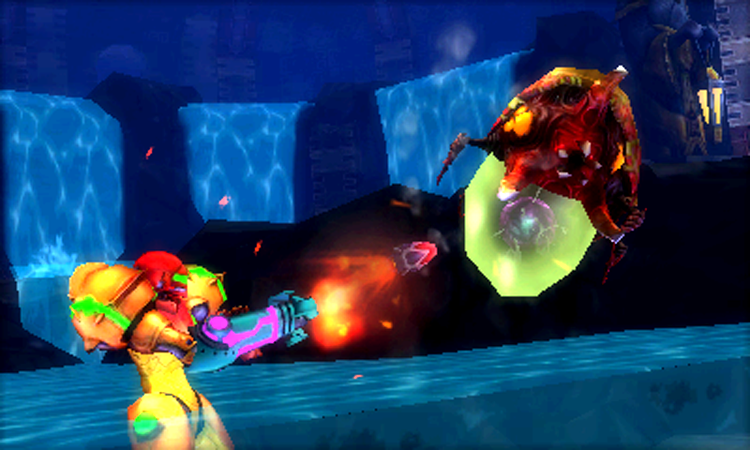Metroid: Samus Returns review – MercurySteam proves there's life yet in Nintendo's sci-fi series
Castlevania veterans seize their opportunity with remake of 26-year-old GameBoy title.

Metroid has always stood out among Nintendo properties. Whereas Mario, Kirby and Animal Crossing are cosy and welcoming, the exploits of intergalactic bounty hunter Samus Aran have always been foreboding and hostile.
For many years Nintendo has eagerly sought ways to encourage people to play together, but Metroid has always been about Samus battling alone through vast, alien worlds where everything is against her and the player controlling her.
Thirteen years have passed since the last traditional, side-scrolling Metroid game, and in that time the series has only slipped further into obscurity.
It looked as though Samus had slayed her last metroid, but at E3 2017 Nintendo hit fans with a double whammy: announcing Metroid Prime 4 for Nintendo Switch and Metroid: Samus Returns for 3DS. Suddenly, the stagnant series was back in a big way.
The former will continue the legacy of Retro Studios' first-person iteration of Metroid, while the latter is a remake of Game Boy title Metroid 2: The Return of Samus made in the traditional mould of the series.
The Prime sequel is years away at this point, but fans haven't had to wait long for Samus Returns. Nintendo's 3DS handheld always seemed like it would be the perfect destination for a classic Metroid title, and now fans have the proof.


Metroid: Samus Returns
Platforms: 3DS
Developer: MercurySteam
Publisher: Nintendo
Release Date: 15 September
MercurySteam, best known for the Castlevania series, are the team behind Samus Returns, and it's a fitting union given the team's history with the Metroidvania genre's other namesake.
If, for whatever reason, anyone harboured doubts about the studio's suitability, they're quickly dismissed by the game itself, which quickly impresses not only with how right it feels as a Metroid game, but how fantastic it looks.
The Spanish developer has worked from scratch to create a setting the first game never really had, due to the limitations of the GameBoy. What they've made captures that alien feel Metroid is known for, with Ancient Egyptian and Aztec influences in the mysterious motifs.
The console's autostereoscopic effect is also utilised wonderfully to lend depth to planet SR388.
Samus Returns' intro, soundtrack and visual design instantly make fans feel at home, then MercurySteam starts to introduce the many ways it has modernised the series' core gameplay.
The ability to lock Samus in position and freely aim around her is a no-brainer that instantly offers Metroid a greater freedom - like when Game Freak finally gave the Pokémon series diagonal movement in X & Y.
Samus can also now counter attacks with well-timed melee strikes that render enemies inert and easy to dispatch. This is simple when threats are on their own, but requires greater skill when navigating areas busy with enemies and other threats.
Four major new abilities – called Aeion abilities – use up a gauge refilled with energy dropped by downed foes. The first of these abilities is a local scan that can reveal hidden items and adjoining rooms Samus could potentially reach. Another casts a field around her suit that makes her immune to enemy attacks and some (but not all) environmental hazards.
These abilities gel well with the traditional elements of a Metroid adventure, and can be used to great effect in later boss battles. As with health and missile stock, the Aeion gauge can be upgraded as you progress.


The game's set-up is the same as the original, with a locked number of metroids that Samus will dispatch over its 12-15 hour runtime. They're split between each area, where players find altars that require a certain number of the parasitic aliens to be killed before a poisonous liquid blocking off new areas can be drained.
Metroid is about exploring alien worlds and retreading your steps once you've unlocked new abilities, and here that core loop is as strong as it's ever been. The extermination set-up maps well with this loop, and offers fans something technically old, but which still feels fresh.
Quickly, Samus Returns finds a rhythm that continues to work many hours into the game... until things start to drag.
There being 40 metroids to take out means 40 boss battles, albeit with room for more. That's quite a lot, and in the second half of the game that starts to become apparent. Repeating fights is understandable given the quantity, but overall MercurySteam doesn't do enough to differentiate them.
This is particularly true in the middle stretch of the game. There are new types of metroid to contend with, some are engulfed in flame or ice, and some battles take place over multiple stages in different rooms, but for a long stretch the changes don't give the game the shot it needs.
By the time more significant new elements are introduced, the game is already in its final stretch having given players a string of new abilities in quick succession, making them feel almost too powerful. That feeling is short-lived, but in letting players freedom to course through the game briefly as Samus at her most powerful, it makes the coming challenge all the more effective.
MercurySteam takes no time at all proving it is the perfect fit for a series overdue a resurgence. Another studio may have recreated Metroid as it was, but the Castlevania veterans modernise the Nintendo franchise with new abilities, freer movement, quality animations and lush alien design brimming with mystery and the unknown.
If this remake was a test to see if there's life yet in the franchise, it passes with flying colours, only let down by a lack of the memorable boss encounters the series is known for. Maybe in a sequel the MercurySteam team could address this. They've certainly earned the right to try.
© Copyright IBTimes 2025. All rights reserved.
























